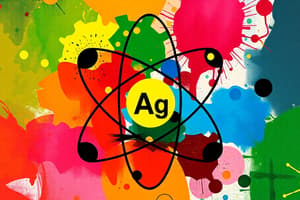Podcast
Questions and Answers
What is the main reason for understanding the differences between metals and non-metals?
What is the main reason for understanding the differences between metals and non-metals?
How are metals typically classified in the periodic table?
How are metals typically classified in the periodic table?
Which of the following is NOT a characteristic of metals?
Which of the following is NOT a characteristic of metals?
What is the unique property of mercury among metals?
What is the unique property of mercury among metals?
Signup and view all the answers
What do metals have that allows them to conduct heat and electricity?
What do metals have that allows them to conduct heat and electricity?
Signup and view all the answers
What is the general state of metals at room temperature?
What is the general state of metals at room temperature?
Signup and view all the answers
What is a common characteristic of non-metals?
What is a common characteristic of non-metals?
Signup and view all the answers
What happens when a metal reacts with a non-metal?
What happens when a metal reacts with a non-metal?
Signup and view all the answers
What is a common use of non-metals?
What is a common use of non-metals?
Signup and view all the answers
What is a characteristic of metals when they react with oxygen?
What is a characteristic of metals when they react with oxygen?
Signup and view all the answers
What is the term used to describe the tendency of metals to lose electrons?
What is the term used to describe the tendency of metals to lose electrons?
Signup and view all the answers
What is the general property of non-metals in terms of their conductivity?
What is the general property of non-metals in terms of their conductivity?
Signup and view all the answers
Study Notes
Metals and non-metals are two distinct groups of elements that play crucial roles in various aspects of our lives. Understanding these differences is essential for various scientific and technological applications. In this article, we will discuss the properties, uses, and differences between metals and non-metals.
Definition and Classification
Elements are the fundamental building blocks of matter. The periodic table, a chart that arranges all the known elements, categorizes them into three main groups: metals, non-metals, and metalloids.
Metals are elements that typically have one, two, or three electrons in their outermost shell. Non-metals, on the other hand, have 4, 5, 6, or 7 electrons in their outermost shell.
Properties of Metals
- Metals are typically hard: Most metals are hard and can withstand significant pressure without breaking. However, there are exceptions like sodium, potassium, and mercury, which are relatively soft.
- Lustrous: Metals are shiny and reflective, which makes them easy to see and use.
- Good conductors of heat and electricity: Metals have free electrons that can move easily, allowing them to conduct heat and electricity.
- Malleable and ductile: Metals can be shaped or drawn into wires without breaking.
- High density: Metals generally have high densities.
- Solid at room temperature: Most metals are solid at room temperature, except for mercury, which is a liquid metal at this temperature.
- React with oxygen: Metals react with oxygen to form basic oxides, which often have a white or silver-like appearance.
- React with water: Some metals, like potassium, calcium, and sodium, can react with water and displace hydrogen to form metal hydroxides.
Properties of Non-metals
- Non-metals are generally soft: Non-metals are typically soft and can be cut with a knife.
- Non-lustrous: Non-metals do not reflect light and are not shiny.
- Poor conductors of heat and electricity: Non-metals have fewer free electrons and do not conduct heat and electricity as well as metals.
- Brittle: Non-metals tend to be brittle and can break into pieces if struck.
- Low density: Non-metals generally have lower densities than metals.
- Solid, liquid, or gas at room temperature: Non-metals exist in all three states at room temperature, including solids, liquids, and gases.
- React with oxygen: Non-metals can react with oxygen to form acidic oxides.
- React with water: Non-metals like chlorine and nitrogen do not react with water.
Uses of Metals and Non-metals
Metals and non-metals have various applications in our daily lives:
- Metals are used in construction, transportation, and electronics due to their strength, ductility, and electrical conductivity.
- Non-metals are used in various industries, such as pharmaceuticals and agriculture, and are also essential components of our food and water.
How Metals and Non-metals React
Metals and non-metals react chemically by sharing electrons to form bonds. Metals are electropositive, meaning they lose electrons to form positive ions. Non-metals are electronegative, which means they attract electrons to form negative ions. When a metal reacts with a non-metal, they form ionic bonds, which are strong and stable.
Conclusion
Metals and non-metals are essential components of our world, each with unique properties and applications. Understanding the differences and similarities between these two groups help us harness their potential for various purposes.
Studying That Suits You
Use AI to generate personalized quizzes and flashcards to suit your learning preferences.
Description
Explore the fundamental differences between metals and non-metals, including their properties, uses, and reactions. Learn how to classify elements and understand their importance in various scientific and technological applications.




